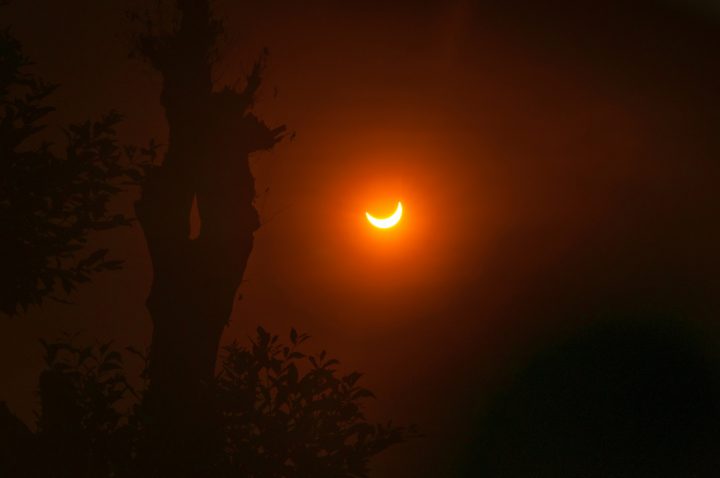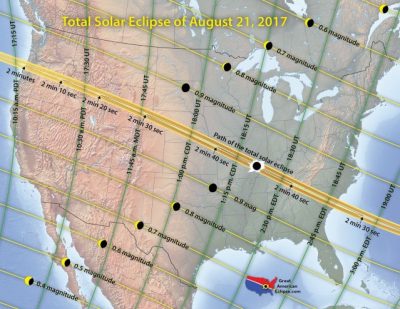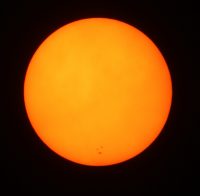
Reprinted from the Tideland News
EASTERN NORTH CAROLINA — In late winter of March 1970, three young boys, not quite teenagers, stood in an open field awash with brilliant sunshine in rural eastern North Carolina. They hovered over a rickety science project that was going to show them one of the greatest natural phenomenons to be witnessed on earth.
Supporter Spotlight
With their homemade pinhole solar projector in place, they waited; they waited to see the total eclipse of the sun. For these kids, the thought of the moon blotting out the sun was spooky, eerie and downright scary, but they weren’t going to miss it for anything.

On Aug. 21, eastern North Carolina is going to witness another solar eclipse.
While the central North Carolina coast is not in the path of totality, we will experience a close to 95 percent partial eclipse. As the moon begins to pass between the sun and the earth, those first to fall under darkness will be on the west coast in Oregon.
A 70-mile wide shadow, called the umbra of the moon, will begin to race diagonally across the states at 1,452 miles per hour until it spills into the Atlantic Ocean at Cape Island, South Carolina.
It will take the shadow just under 100 minutes to pass through 12 states, which include the extreme western tip of North Carolina.
Supporter Spotlight
If you want to see the total eclipse you are going to need to travel. From our coastal area, the best option is to travel to the Georgetown or Charleston, South Carolina area. Otherwise, viewing in the central coast of North Carolina will consist of a big bite taken out of the sun without complete coverage by the moon. Thus, the much anticipated corona halo will not be visible.

The solar eclipse has long fascinated cultures throughout the world resulting in many myths and legends. Many of these myths have a common theme with the sun being eaten by giant animals such as a frog, wolf, snake and even a dragon. One myth involves a big dog trying to steal the sun. Maybe this is why dogs never want to bring the ball back when playing fetch.
The eclipse is also seen as a struggle or fight between the moon and the sun with the sun always prevailing. The intriguing Native American Choctaw legend places responsibility for the solar eclipse directly on a hungry black squirrel. The black squirrel had a strong taste for the sun and would, from time to time, climb into the sky to have a picnic.
The tribe realized that if the black squirrel consumed the life-giving sun that their world would be plunged into darkness. Whenever the black squirrel headed into the sky to take a chunk out of the sun, the tribe would create as much of a frightening commotion as possible to scare away the squirrel. They would bang drums, yell, scream and even incite their dogs to bark and howl. Each time, the tactic worked as the sun was restored whole.
Even today, it is customary in some cultures to make noise to scare away the spirits that are blocking the sun.
During the period of a total eclipse, nature’s rhythm is temporarily out of beat as darkness descends during the middle of the day. Animals and insects that are active during the day may begin to seek shelter for the night and nocturnal animals may begin to stir. However, as brief as the total eclipse is, they will quickly resume normal behavior.
Even though a total solar eclipse occurs about every 18 months, seeing one in a specific area is quite rare. It is estimated, on average, that a total solar eclipse will occur in a specific area only once every 375 years.
I was one of those excited boys in 1970 standing in the field waiting on the eclipse. I remember the image of a crescent shape biting into the ball of sun illuminated through our pinhole projector.
“It’s happening, it’s really happening”, we exclaimed, under a darkening sky.

We watched the moon chew through the sun until the sun was obscured. One of my friends had brought along a thick plate of smoke-colored glass used in welding helmets that his grandfather let us borrow. Stunned, we took turns looking at the corona through the scratched, dark welding glass, fearful that our eyes would be vaporized otherwise.
For some reason, I remember dogs barking and roosters crowing. Whether this was reality or a memory embellished, I don’t really recall. As the moon slipped away and the sun returned to its glory, we were proud little scientists. We had seen a solar eclipse and survived to tell the tale.
According to the website timeanddate.com, in the Emerald Isle, North Carolina area, the duration of the eclipse will last for 2 hours and 48 minutes starting at 1:21 p.m. with the peak coverage at 2:49 p.m. and ending at 4:10 p.m.
I’ll be hoping for clear weather on Aug. 21, to see, once again, this spectacle of our amazing world.
Experience the Eclipse
- How to safely view a partial eclipse
- Ocracoke will have a ringside seat to see almost all of a total solar eclipse Aug. 21
- Solar Eclipse Experience with Core Sound Waterfowl Museum, Cape Lookout
- NC Aquarium at Roanoke Island Solar Eclipse Event
- Solar Eclipse Party at Arlie Gardens in Wilmington
- Ingram Planetarium at Sunset Beach
- Dismal Swamp State Park Eclipse Viewing Party
- Hammocks Beach State Park’s A Shadow Show: Solar Eclipse
- Goose Creek State Park Solar Eclipse Party
- Pettigrew State Park Solar Eclipse Viewing Party
- Jockey’s Ridge State Park Partial Solar Eclipse Viewing
This story is provided courtesy of the Tideland News, a weekly newspaper in Swansboro. Coastal Review Online is partnering with the Tideland to provide readers with more environmental and lifestyle stories of interest about our coast. You can read other stories about the Swansboro area here.







